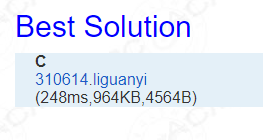NOIP 2015 斗地主
Description
牛牛最近迷上了一种叫斗地主的扑克游戏。斗地主是一种使用黑桃、红心、梅花、方片的A到K加上大小王的共54张牌来进行的扑克牌游戏。在斗地主中,牌的大小关系根据牌的数码表示如下:3<4<5<6<7<8<9<10<J<Q<K<A<2<小王<大王,而花色并不对牌的大小产生影响。每一局游戏中,一副手牌由n张牌组成。游戏者每次可以根据规定的牌型进行出牌,首先打光自己的手牌一方取得游戏的胜利。
现在,牛牛只想知道,对于自己的若干组手牌,分别最少需要多少次出牌可以将它们打光。请你帮他解决这个问题。
需要注意的是,本题中游戏者每次可以出手的牌型与一般的斗地主相似而略有不同。具体规则如下:

Input
第一行包含用空格隔开的2个正整数 T , n ,表示手牌的组数以及每组手牌的张数。
接下来 T 组数据,每组数据 n 行,每行一个非负整数对 ai , bi ,表示一张牌,其中 ai 表示牌的数码,bi 表示牌的花色,中间用空格隔开。特别的,我们用 1 来表示数码A,11表示数码J,12表示数码Q,13表示数码K;黑桃、红心、梅花、方片分别用1-4来表示;小王的表示方法为0 1,大王的表示方法为0 2。
Output
共 T 行,每行一个整数,表示打光第 i 组手牌的最少次数。
Sample Input
1 8 7 4 8 4 9 1 10 4 11 1 5 1 1 4 1 1
Sample Output
3
HINT
【数据规模与约定】
对于不同的测试点,我们约定手牌组数 T 与张数 n 的规模如下:
数据保证:所有的手牌都是随机生成的。
| 测试点编号 | T | n | 测试点编号 | T | n |
|---|---|---|---|---|---|
| 1 | 100 | 2 | 11 | 100 | 14 |
| 2 | 100 | 2 | 12 | 100 | 15 |
| 3 | 100 | 3 | 13 | 10 | 16 |
| 4 | 100 | 3 | 14 | 10 | 17 |
| 5 | 100 | 4 | 15 | 10 | 18 |
| 6 | 100 | 4 | 16 | 10 | 19 |
| 7 | 100 | 10 | 17 | 10 | 20 |
| 8 | 100 | 11 | 18 | 10 | 21 |
| 9 | 100 | 12 | 19 | 10 | 22 |
| 10 | 100 | 13 | 20 | 10 | 23 |
最优解声明:

题解:
%%%枫哥
搜索+大模拟。
考场上反正我是不敢开正解,这题太细了(bushi
所以先打了个30p垫底。
30pts:
#include<cstdio>
#include<algorithm>
#include<cstring>
using namespace std;
int n,tot,opt;
int cnt[16];
bool flag;
int main()
{
int t;
scanf("%d%d",&t,&n);
while(t--)
{
memset(cnt,0,sizeof(cnt));
flag=0,tot=0;
for(int i=1,x;i<=n;i++)
{
scanf("%d%d",&opt,&x);
cnt[opt]++;
}
if(n==2)
{
for(int i=0;i<=13;i++)
if(cnt[i]==2)
{
puts("1");
flag=1;
break;
}
if(flag)
continue;
puts("2");
}
if(n>=3)
{
for(int i=0;i<=13;i++)
{
if(cnt[i]>=3)
{
puts("1");
flag=1;
break;
}
else if(cnt[i])
tot++;
}
if(flag)
continue;
printf("%d
",tot);
}
}
return 0;
}
好了,讲正解。
剪枝用最优化剪枝,如果当前步数大于已知最小步数,直接停。
剩下的,依题意模拟即可。(别打我)
代码有注释。
#include<cstdio>
#include<cstring>
#include<algorithm>
using namespace std;
const int INF=998244353;
int t,n,ans;
int cnt[20];
bool prune(int x)
{
if(x>=ans)
return 1;
return 0;
}
void shengxiade(int x)
{
int now=x;
for(int i=2;i<=15;i++)
if(cnt[i])
now++;
ans=min(ans,now);
}
void dfs(int x)
{
if(prune(x))
return;//剪枝
//以下是顺子部分
int tot=0;
for(int i=3;i<=14;i++)
if(cnt[i]<1)
tot=0;
else
{
tot++;
if(tot>=5)
{
for(int j=i-tot+1;j<=i;j++)
cnt[j]--;
dfs(x+1);
for(int j=i-tot+1;j<=i;j++)
cnt[j]++;
}
}//单
tot=0;
for(int i=3;i<=14;i++)
if(cnt[i]<2)
tot=0;
else
{
tot++;
if(tot>=3)
{
for(int j=i-tot+1;j<=i;j++)
cnt[j]-=2;
dfs(x+1);
for(int j=i-tot+1;j<=i;j++)
cnt[j]+=2;
}
}//双
tot=0;
for(int i=3;i<=14;i++)
if(cnt[i]<3)
tot=0;
else
{
tot++;
if(tot>=2)
{
for(int j=i-tot+1;j<=i;j++)
cnt[j]-=3;
dfs(x+1);
for(int j=i-tot+1;j<=i;j++)
cnt[j]+=3;
}
}//三
//以下是带牌部分
for(int i=2;i<=14;i++)
{
if(cnt[i]==3)
{
for(int j=2;j<=14;j++)
{
if(j==i||cnt[j]<2)
continue;
cnt[i]-=3;
cnt[j]-=2;
dfs(x+1);
cnt[i]+=3;
cnt[j]+=2;
}//三带二
for(int j=2;j<=15;j++)
{
if(j==i||cnt[j]<1)
continue;
cnt[i]-=3;
cnt[j]--;
dfs(x+1);
cnt[i]+=3;
cnt[j]++;
}//三带一
}
if(cnt[i]==4)
{
for(int j=2;j<=14;j++)
{
if(j==i||cnt[j]<2)
continue;
cnt[i]-=3;
cnt[j]-=2;
dfs(x+1);
cnt[i]+=3;
cnt[j]+=2;
}//三带二
for(int j=2;j<=15;j++)
{
if(j==i||cnt[j]<1)
continue;
cnt[i]-=3;
cnt[j]--;
dfs(x+1);
cnt[i]+=3;
cnt[j]++;
}//三带一
for(int j=2;j<=14;j++)
{
if(j==i||cnt[j]<2)
continue;
for(int k=2;k<=14;k++)
{
if(k==i||k==j||cnt[k]<2)
continue;
cnt[i]-=4;
cnt[j]-=2;
cnt[k]-=2;
dfs(x+1);
cnt[i]+=4;
cnt[j]+=2;
cnt[k]+=2;
}
}//四带二
for(int j=2;j<=15;j++)
{
if(j==i||cnt[j]<1)
continue;
for(int k=2;k<=15;k++)
{
if(k==i||k==j||cnt[k]<1)
continue;
cnt[i]-=4;
cnt[j]--;
cnt[k]--;
dfs(x+1);
cnt[i]+=4;
cnt[j]++;
cnt[k]++;
}
}//四带一
}
}
shengxiade(x);
}
int main()
{
scanf("%d%d",&t,&n);
while(t--)
{
memset(cnt,0,sizeof(cnt));
ans=INF;
for(int i=1,x,y;i<=n;i++)
{
scanf("%d%d",&x,&y);
if(x==0)
cnt[15]++;
else if(x==1)
cnt[14]++;
else
cnt[x]++;
}
dfs(0);
printf("%d
",ans);
}
return 0;
}